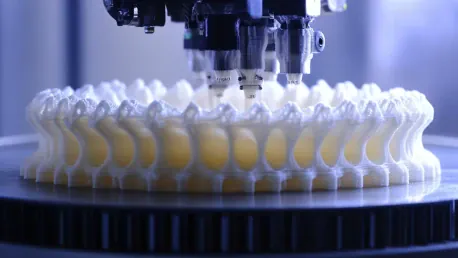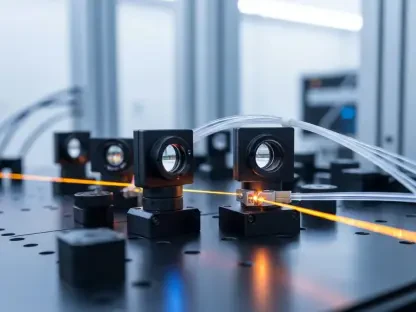In recent years, Empa researchers have made significant strides in creating 3D-printed soft material actuators that closely mimic the function of biological muscles. This technology has promising implications for various applications in medicine, robotics, and beyond. The innovative method developed by Empa enables the production of these flexible and potent structures using advanced 3D printing techniques, paving the way for future breakthroughs.
A Method to Mimic Muscles
Dielectric elastic actuators, or DEAs, are soft actuators designed to function like real muscles by leveraging silicone-based materials. These actuators consist of layers of conductive and non-conductive materials that interlace like fingers, creating a structure that contracts when electrical voltage is applied and reverts to its initial form when the voltage is removed, thereby simulating muscle movement. This innovative design promises new capabilities for devices needing movement on demand.
The development of these actuators involves addressing substantial engineering challenges, particularly ensuring the two very different silicone materials behave similarly during the 3D printing process. Achieving this precision is essential for the materials to interlock properly without mixing and to maintain the required softness and elasticity to effectively respond to electrical stimuli. These critical properties allow the actuators to simulate biological muscle behavior accurately, enabling a vast array of potential applications.
Addressing Engineering Challenges
One of the primary obstacles in creating these soft actuators is ensuring that the silicone materials can liquefy under pressure for extrusion from the printer nozzle while retaining their shape post-printing. Balancing these competing properties required meticulous research and posed a significant challenge, as maintaining the structural integrity of the materials while achieving their necessary functionality is complex. Successfully producing actuators that meet these criteria marks an important engineering milestone.
Researchers have focused extensively on reconciling the opposing properties of the silicone materials by working with experts from ETH Zurich to develop specialized nozzles for the 3D printing process. Together, they devised innovative solutions that facilitated the successful integration of these materials, allowing the creation of actuators capable of mimicking muscle movement. This collaboration underscores the importance of interdisciplinary cooperation in solving complex technical challenges and driving advancements in soft actuator technology.
Collaboration Driving Innovation
The partnership between Empa’s Laboratory for Functional Polymers and ETH Zurich highlights the critical role that interdisciplinary collaboration plays in technological innovation. By bringing together expertise from different fields, the teams managed to overcome significant technical challenges, advancing the development of functional soft actuators. This concerted effort exemplifies what can be accomplished through collaborative research, fostering potential breakthroughs in various applications.
One of the notable initial applications of these actuators is in the Manufhaptics project, which includes developing a glove that allows for tangible interaction with virtual objects. This application represents a major leap forward in haptic feedback technology, offering users a more immersive and realistic experience in virtual environments. Demonstrating the versatility of these actuators, this project signifies a critical advancement in their potential use cases and showcases the tangible benefits of interdisciplinary innovation.
Diverse Applications
The potential uses for these soft actuators extend far beyond the scope of haptic feedback in virtual reality gloves. Their lightweight, noiseless, and flexible nature makes them ideal candidates for replacing conventional rigid actuators in a variety of industries, including automotive, industrial machinery, and robotics. By integrating these actuators, larger systems could become more efficient, quieter, and capable of more complex movements, thus transforming the way machines interact with their environments and users.
Beyond industrial applications, this 3D-printed technology holds significant promise for medical advancements. Future developments could see actuators used in artificial muscle tissue replacements, offering new therapeutic options for patients with muscle damage or degenerative conditions. Researchers envision ambitious innovations such as printing entire organs, like hearts, using these fibers. While this remains a long-term goal, the strides already made provide a hopeful glimpse into future medical breakthroughs.
Exciting Possibilities
The ability to create long elastic fibers that mimic the behavior of natural muscles is a crucial achievement for the ongoing development of this technology. Empa researchers’ dedication to fine-tuning the properties of these 3D-printed actuators reflects significant progress toward accurately replicating the functionality of real muscles. The capabilities demonstrated by these actuators underscore their potential as versatile tools applicable across numerous fields, showcasing the promise of future innovations.
Despite considerable challenges that remain, the progress made thus far signifies a promising step towards the development of versatile tools with broad applications. By intricately balancing and integrating diverse materials to achieve desired properties, researchers have laid the groundwork for practical and effective solutions that could revolutionize medical and technological landscapes. This delicate engineering feat underscores the innovative spirit driving research in this exciting area.
Ongoing Research Efforts
Over the past few years, researchers at Empa have made remarkable progress in the development of 3D-printed soft material actuators that closely resemble the function of natural muscles. This cutting-edge technology holds great potential for a wide range of applications, particularly in the fields of medicine and robotics. The innovative techniques devised by Empa offer the capability to produce flexible and powerful structures through advanced 3D printing methods, paving the way for future groundbreaking developments.
The researchers have been experimenting with various materials and printing techniques to optimize the performance and durability of these synthetic muscles. By fine-tuning the mechanical properties and ensuring that they can endure repeated use, these actuators have shown promising results in mimicking the movements and functionality of real muscles. This breakthrough could revolutionize the design and implementation of prosthetics, wearable robots, and even responsive surfaces in architecture. The ability to replicate the complex movements of biological muscles with artificial systems represents a significant leap forward in technology.









